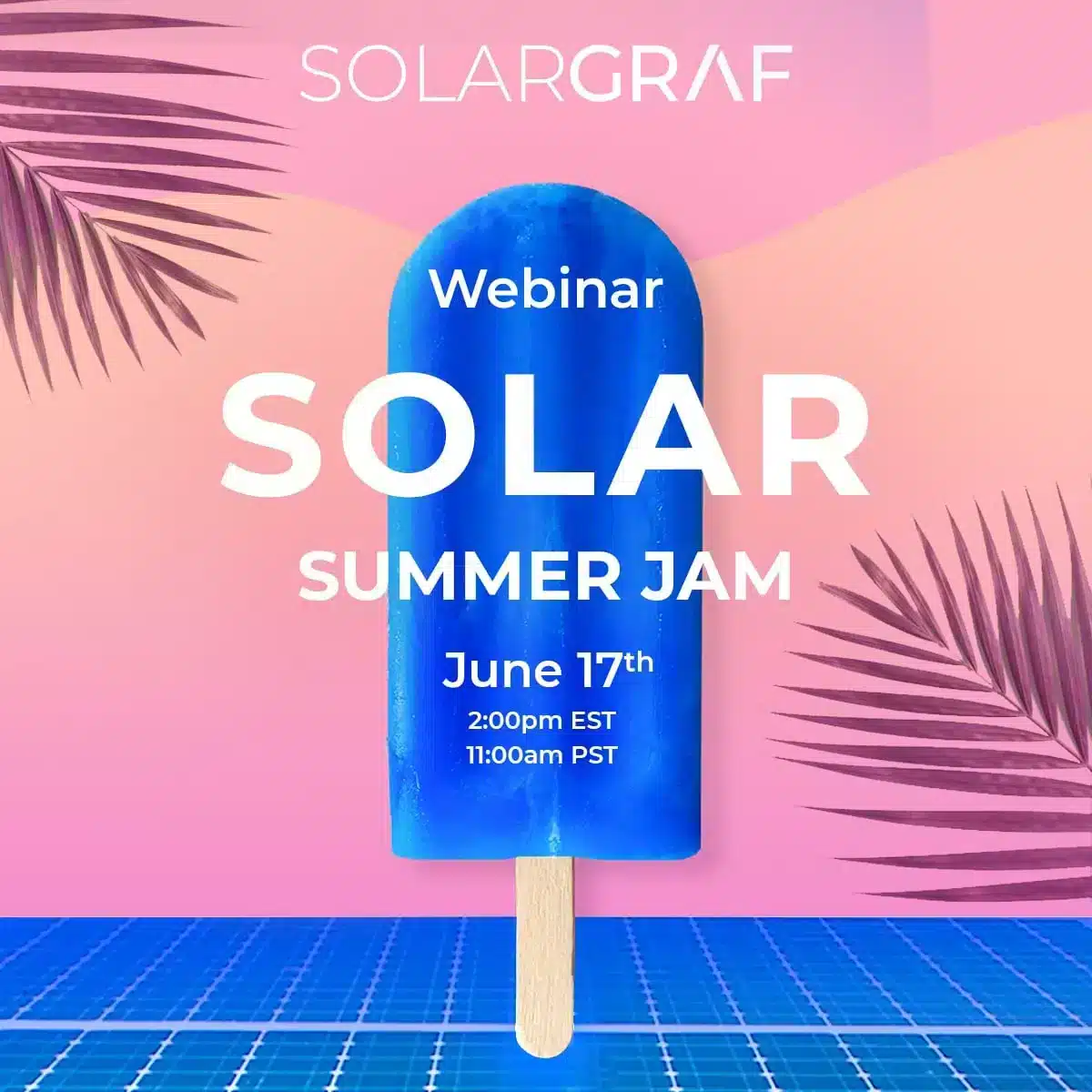Missed our Virtual Solar Summer Jam webinar or simply want to share it with a friend? View/share the recording to the left or skim through the highlights below!
Lennie Moreno, CEO, Sofdesk
We decided to organize the 2020 Virtual Solar Summer Jam this year because, even with the lockdown and restrictions that are happening, we wanted to make sure that we bring some good vibes and positivity.
Most sources globally are all seeing between a 3 – 5% decline from year to year which really isn’t that much of a setback. We know it’s going to be a wonderful summer so we’ll be bringing positivity, value, and new exciting features to you in this webinar.
Elba Nino, Marketing Director, Sofdesk
We know that 2020 has been challenging but we need to focus on how to close it out strong and make the rest of the year work for us. Today, we’re going to focus on two things to help market our solar businesses:
- How to find our own leads.
- How to market out solar businesses in a way for prospects to find us.
Firstly, I want to talk about your Unique Value Proposition (UVP) because that’s one thing that differentiates us from our competition. To get your own leads, we need to use the resources that we have now, many of which are free. This means we need to make sure our websites are ready to receive leads. You need to have a place on your website where your prospects can come and leave their information.
In order for someone to give you their contact information, you need to give them something of value in return. This is called a “lead magnet” – a piece of content or an offer that you create in exchange for information. This could be a guide on solar batteries or a free consultation, for example.
Once you have their email, you need to create an email workflow where you ask your prospects who they are and what it is they want from your company. Depending on the answer, you can filter your leads based on their needs.
In terms of social media, make sure your posts are localized. This means that you should be using local hashtags and participating in community discussions to make yourself into an authority in your area.
Another thing you can do to get your name out there is to use paid channels. On Facebook, for example, you can create paid ads or boost organic posts so they reach a larger audience. A suggestion: you can boost a post to reach people that own houses within a 20-mile radius of your location.
One thing clients ask me a lot is “how much money do I need to set aside to advertise my business?”. It all depends on the results you’re looking for. If you want more leads, use the same logic that you use when you’re buying leads from a different medium. If you’re willing to spend $50 per lead and are happy to get 20 leads a month, then your advertising budget should be $1000.
Finally, let’s talk about Local Search Engine Optimization (SEO). This is the ability to market your business online at the same time your prospects are looking for your services. Ideally, you want to be in the top three Google search results. To do that, get your name in Google My Business by claiming your profile. It’s also very important for your customers to review your business, because the more reviews you have, the better the chances that Google will show in the search results. Google ranks businesses based on proximity, relevance, and prominence so make sure your website is optimized for these categories.
Hesham Habib, Solargraf Team Lead, Sofdesk
I want to talk about how financing is modeled in Solargraf. To do so, you can go to your Financial Options and model any type of loan you require. Our management has also done a great job establishing partnerships with some loan providers. We currently have Mosaic, Greensky and GoodLeap integrated into Solargraf. This means that if you work with any of these providers, you’re able to integrate your account directly into Solargraf to be able to submit an application for approval. A lot of these providers require that you’re in business for two years and have a good record of installs completed.
Editor’s note: to see the Virtual Site Assessment feature in action, skip to 23:50 in the recording.
One super cool feature that we launched due to the pandemic is the Virtual Site Assessment. In Solargraf, you can submit a request for a site assessment to the client. They will get an email asking them to complete a web form where they can provide all the information you need to complete the assessment. You can request pictures of the roof, any utility bills, etc.
You, as the installer will then receive all of this information on the project page. This speeds up the process by allowing you to get all the information you need for permitting or anything else you need from the homeowner without driving over to the home.
Joseph Marhamati, VP & Co-Founder, Ipsun Solar
Lennie: I would like to start off by asking you a bit about what the main thing that your company did that brought you value in terms of switching from not being able to meet your clients to moving to a completely virtual process? Can you share a bit about your experience in general so the attendees can understand how you can thrive and grow your business while being under lockdown?
Joseph: I think it all begins with the base value proposition of Solargraf which is that, because it’s a great tool for conveying the value proposition of solar to a customer, it keeps you from having to necessarily go to the home every single time. Because you have Nearnap, EagleView, Bing, and Google Maps integrated with Solargraf, you can get a design to a customer that is 90% – 95% accurate in most cases.
This means that in an area like D.C., with a lot of traffic where people are working 60 hours a week, you can book a screen share with them, send them a proposal, update it in real-time and show them different options quickly. This is what most people care about, they don’t want to know every single detail at first. If your value proposition resonates with the customer, they will likely be on board. Now our sales are going up even though all of them are virtual, which Solagraf has made possible.
Most people can use Solargraf to do a virtual site survey in 30 minutes which speeds up the process. Now you don’t need as many people involved and the homeowner feels like they can be part of the process, which we’ve been using as a selling point. A process that might have taken 2 – 3 weeks with an in-person survey can now be done in a few days. We send a video with instructions and customers love it. This is something that will stick around long after COVID-19 because customers really appreciate this.
Lennie: Do you feel that when you’re competing for a job with other dealers in the area, does that give you an edge in terms of the speed at which you get a signature from the homeowner?
Joseph: I think so. It’s not a liability at all and it’s actually something you can sell on because customers like being a part of the process if it’s something easy for them to do. They feel like they’re being useful and like they’re learning, especially if it speeds up the process. I think this feature is going to cut a couple of weeks off of project development and it’s something any solar company can sell on as a feature.
Rob Stephenson, Partner Channel Manager, Nearmap
Our value offering to our customers is the currency and the clarity in our imagery. A little bit about our organization: we specialize in hi-res aerial imagery. What sets us apart from other imagery providers is our model. We’re not an organization that typically flies on demand. Other providers in the space will wait for a city or county’s request for a flight. Our model just puts planes in the air and captures imagery where the people are. We update our imagery 1 – 2 times a year in the U.S., in Canada we update about twice per year.
There are a lot of industries that need updated imagery, solar specifically is a very sticky industry for us for many reasons, especially having frequently updated information of homes that might not yet be visible on traditional satellite images.
One of the questions I get often is how we get our imagery: we don’t use satellites or drones, we rely on airplanes exclusively. We place our patented camera system inside the belly of an aircraft and we fly over those metros.
You can visualize our cameras swinging on a pendulum which allows us to get a lot of coverage and great overlap which helps us build robust 3D models as well. You can typically see about 3x more clarity with Nearmap than Bing or Google Maps.
As you all know very well, using high-resolution imagery is going to deliver higher accuracy. Your accuracy is really a function of the clarity you have so if your imagery input is not very high resolution, your accuracy is going to be off. Nearmaps accuracy is going to be plus or minus 6 inches. This means that using Nearmap inside of Solargraf will deliver much higher accuracy with our hi-res imagery.
As well as capturing updated images, we’re also keeping records over time of historical imagery. This enables you to go back in time and see how properties have changed which has been a huge value-add for our solar partners and customers as well.
Jamie Wallace, Solargraf Account Executive, Sofdesk
To view Jamie’s Solargraf product demo, skip to 44:00 in the recording.
Q&A
Q: After I get notified from a customer opening the quote, when is the best time to follow up with them?
A: Wait for around 1 – 5 minutes, call them and let them know you’re available for any questions. Strike while the iron is hot!
Q: Can you speak about the after-sales service and what we can do to ensure happy clients and positive reviews?
A: It’s all based on transparency. If there are any delays, hiccups, problems with the city, etc., alter the Project Steps and change the date of the deliverables to notify the client and give them a timeline. It’s the same thing with after-sales – you can add the monitoring step, the final inspection, etc. with dates as well.
Q: What happens if I use drones and not Nearmap?
A: It’s good to have a drone for the final inspection but while you’re selling, it’s costing you too much to use a drone. Especially now since you can’t use drones in many states. You can also do designs in Solargraf with drone imagery and even blueprints if you’d like to.
Q: Will black frame panels be available soon?
A: We currently have blue, black, and thin-film type panels but I will make sure to commit to adding that to the roadmap. I would definitely try thin-film as well in the meantime since they’re quite similar.




 United States
United States Germany/Austria
Germany/Austria Brazil
Brazil Netherlands
Netherlands